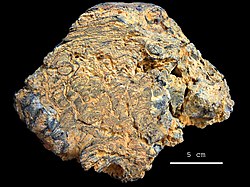Our website is made possible by displaying online advertisements to our visitors.
Please consider supporting us by disabling your ad blocker.
Paleoproterozoic
| Paleoproterozoic | ||||||
|---|---|---|---|---|---|---|
 Paleoproterozoic stromatolites | ||||||
| Chronology | ||||||
| ||||||
| Proposed redefinition(s) | 2420–1780 Ma Gradstein et al., 2012 | |||||
| Proposed subdivisions | Oxygenian Period, 2420–2250 Ma Gradstein et al., 2012 | |||||
| Etymology | ||||||
| Name formality | Formal | |||||
| Alternate spelling(s) | Palaeoproterozoic | |||||
| Usage information | ||||||
| Celestial body | Earth | |||||
| Regional usage | Global (ICS) | |||||
| Time scale(s) used | ICS Time Scale | |||||
| Definition | ||||||
| Chronological unit | Era | |||||
| Stratigraphic unit | Erathem | |||||
| Time span formality | Formal | |||||
| Lower boundary definition | Defined Chronometrically | |||||
| Lower GSSA ratified | 1991[1] | |||||
| Upper boundary definition | Defined Chronometrically | |||||
| Upper GSSA ratified | 1991[1] | |||||
The Paleoproterozoic Era[4] (also spelled Palaeoproterozoic) is the first of the three sub-divisions (eras) of the Proterozoic eon, and also the longest era of the Earth's geological history, spanning from 2,500 to 1,600 million years ago (2.5–1.6 Ga). It is further subdivided into four geologic periods, namely the Siderian, Rhyacian, Orosirian and Statherian.
Paleontological evidence suggests that the Earth's rotational rate ~1.8 billion years ago equated to 20-hour days, implying a total of ~450 days per year.[5] It was during this era that the continents first stabilized.[clarification needed]
- ^ a b Plumb, K. A. (June 1, 1991). "New Precambrian time scale". Episodes. 14 (2): 139–140. doi:10.18814/epiiugs/1991/v14i2/005.
- ^ "palaeo-". Lexico UK English Dictionary. Oxford University Press. Archived from the original on 2020-06-18. "Proterozoic". Lexico UK English Dictionary. Oxford University Press. Archived from the original on 2020-06-17.
- ^ "Proterozoic". Merriam-Webster.com Dictionary. Merriam-Webster.
- ^ There are several ways of pronouncing Paleoproterozoic, including IPA: /ˌpælioʊˌproʊtərəˈzoʊɪk, ˌpeɪ-, -liə-, -ˌprɒt-, -əroʊ-, -trə-, -troʊ-/ PAL-ee-oh-PROH-tər-ə-ZOH-ik, PAY-, -PROT-, -ər-oh-, -trə-, -troh-.[2][3]
- ^ Pannella, Giorgio (1972). "Paleontological evidence on the Earth's rotational history since early precambrian". Astrophysics and Space Science. 16 (2): 212. Bibcode:1972Ap&SS..16..212P. doi:10.1007/BF00642735. S2CID 122908383.
Previous Page Next Page


